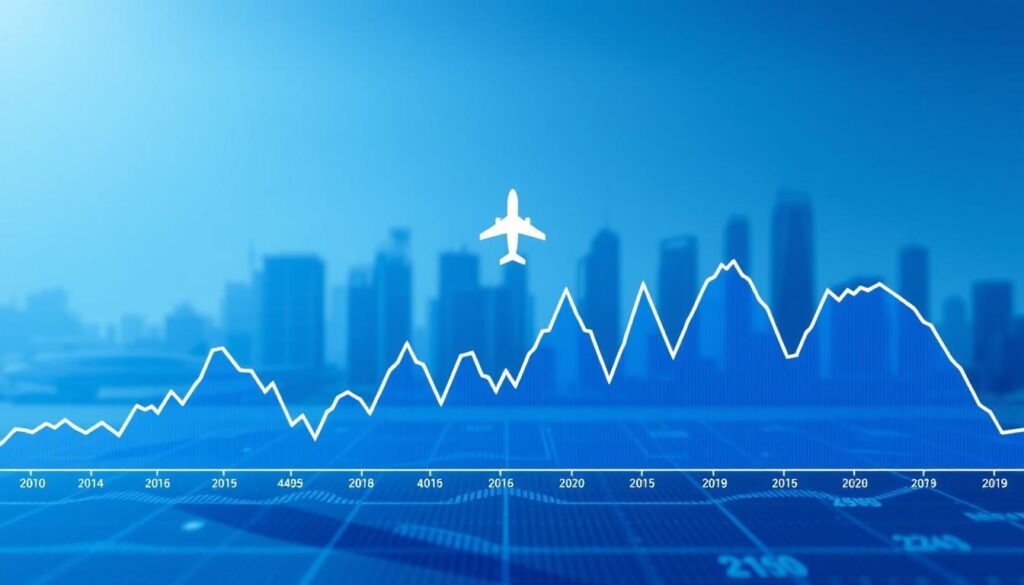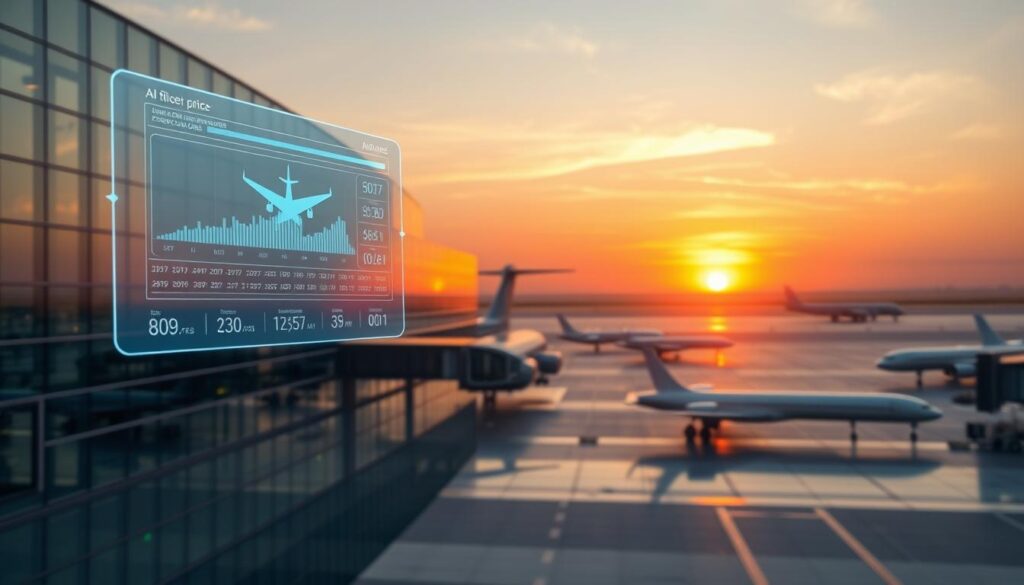The Role of AI in Predicting Flight Prices
Travelers are increasingly turning to AI-powered flight prediction tools to make informed decisions about their flight bookings. With the help of advanced algorithms, these tools can forecast flight price movements with remarkable accuracy.
According to recent developments, AI in flight price prediction is revolutionizing the way we book flights. Companies like Valor Flights have pioneered this approach, developing proprietary algorithms that continuously learn and improve their predictive accuracy. By leveraging tools like Google Flights, travelers can now access price predictions and alerts, helping them determine whether prices are likely to rise or fall.
This transformation is making the flight booking experience more informed and data-driven, allowing travelers to plan their trips around the most cost-effective dates.
Understanding the Volatility of Flight Pricing
The volatility of flight prices is a complex issue, driven by multiple factors that affect the cost of air travel. Market forces play a significant role in determining flight prices, with changes in demand and supply influencing the cost of airline tickets.

Seasonal demand is a key factor in flight price volatility. During peak travel seasons, such as summer and holidays, demand for flights increases, leading to higher prices. In contrast, off-peak seasons see lower demand, resulting in lower prices.
Airline Pricing Strategies
Airlines employ various pricing strategies to maximize revenue. They use dynamic pricing, adjusting prices based on demand, competition, and other factors. Understanding these strategies can help travelers make informed decisions when booking flights.
By recognizing the factors that contribute to flight price volatility, travelers can better navigate the complexities of airfare pricing and make more informed decisions.
The Role of AI in Predicting Flight Prices
Advanced technologies like AI are transforming the flight pricing landscape. The role of AI in predicting flight prices is multifaceted, involving the analysis of vast datasets to identify patterns that can inform price forecasts. This is made possible through the use of sophisticated technologies such as neural networks and deep learning.
Neural Networks and Deep Learning Applications
Neural networks, a crucial component of AI, are designed to mimic the human brain’s ability to learn and adapt. In the context of flight price prediction, these networks analyze historical data, seasonal trends, and real-time market conditions to predict future price movements. Deep learning, a subset of machine learning, further enhances this capability by allowing for the analysis of complex data sets.
Predictive Modeling Techniques
Predictive modeling techniques are at the heart of AI-powered flight price prediction. These techniques involve the use of statistical models to forecast future prices based on historical data. By analyzing a wide range of factors, including demand, fuel prices, and global events, predictive models can provide accurate forecasts of flight prices. The integration of these models with AI technologies has significantly improved the accuracy of flight price predictions.

The combination of neural networks, deep learning, and predictive modeling techniques represents a significant advancement in the field of flight price prediction. As AI continues to evolve, we can expect to see even more accurate and reliable predictions, helping travelers make informed decisions about their flights.
Behind the Scenes: How AI Flight Price Prediction Works
Behind the scenes of AI-powered flight price prediction lies a sophisticated system that leverages multiple advanced technologies to provide accurate forecasts.
The process begins with machine learning algorithms that analyze vast datasets, including historical flight prices, seasonal trends, and real-time market fluctuations. These algorithms enable the AI system to learn from the data and make predictions based on patterns and trends.
Natural Language Processing (NLP) also plays a crucial role in AI flight price prediction. NLP helps the system to understand and interpret data from various sources, such as news articles, social media, and travel industry reports, which can impact flight prices.

Real-time data processing is another essential component of AI flight price prediction. The system continuously monitors and analyzes real-time data, allowing it to adjust its predictions accordingly. This ensures that the forecasts remain accurate and up-to-date.
By combining these technologies, AI-powered flight price prediction systems can provide travelers with reliable and timely information, helping them make informed decisions when booking flights.
Popular AI-Powered Flight Price Prediction Tools
Several AI-powered tools have emerged to help travelers predict and manage flight prices effectively. These tools leverage advanced algorithms to analyze historical data, market trends, and other factors to forecast future price changes.
Airline Revenue Management Systems
Airlines use sophisticated revenue management systems to adjust prices based on demand. These AI-driven systems analyze booking patterns, seasonal trends, and competition to optimize revenue.
Travel Agency Prediction Tools
Travel agencies utilize AI-powered tools to predict price fluctuations, enabling them to advise clients on the best times to book. These tools help in optimizing travel planning.
Mobile apps like Hopper and Skyscanner use AI to track price changes and notify users when prices drop. These apps offer personalized travel recommendations.
Web-Based Prediction Services
Web-based services such as Google Flights and Kayak provide AI-driven price forecasts, helping travelers make informed decisions. These platforms offer detailed price trend analysis.
Benefits and Limitations of AI Price Prediction
AI’s role in flight price prediction is multifaceted, offering both benefits and drawbacks. On one hand, AI-powered prediction models can analyze vast datasets, providing accurate forecasts that help travelers make informed decisions.
The benefits of AI price prediction include improved accuracy and the ability to analyze complex data. This enables travelers to anticipate price changes and plan their bookings accordingly.
However, there are also limitations to consider. For instance, AI algorithms can be biased if the training data is incomplete or skewed. This can lead to inaccurate predictions and affect the reliability of the system.
Moreover, the quality of the training data is crucial for the effectiveness of AI price prediction. High-quality data ensures that the predictions are reliable and accurate. Despite these limitations, the benefits of AI price prediction make it a valuable tool for travelers.
In conclusion, while AI price prediction offers several advantages, including improved accuracy and complex data analysis, it is essential to be aware of its limitations, such as potential bias and the need for high-quality training data.
The Future of AI in Flight Price Forecasting
Emerging trends in AI are expected to significantly impact the future of flight price forecasting. As technology advances, the integration of AI in the travel industry is becoming more prevalent, offering more accurate and personalized predictions.
The future of AI in this domain is closely tied to advancements in quantum computing and advanced natural language processing (NLP). These technologies have the potential to revolutionize the field by providing faster and more sophisticated data analysis.
Quantum Computing Applications
Quantum computing can process vast amounts of data at unprecedented speeds, enabling more accurate forecasting models. This technology can help analyze complex patterns in flight pricing, leading to better predictions.
Advanced Natural Language Processing for Market Sentiment
Advanced NLP can analyze market sentiment by processing large volumes of text data from various sources, including news articles and social media. This capability enhances the understanding of market trends, contributing to more informed price forecasts.
By leveraging these emerging technologies, the travel industry can look forward to more reliable and efficient flight price forecasting, ultimately enhancing the travel planning experience.
Conclusion
As the airline industry continues to evolve, AI in flight price prediction is revolutionizing the way we book flights. By analyzing historical data and real-time market trends, AI-powered prediction tools provide travelers with valuable insights to make informed decisions. The benefits of using these tools include identifying the best times to book, predicting price fluctuations, and optimizing flight itineraries.
With the transformative impact of AI on the flight booking experience, travelers can now make data-driven decisions, ensuring a more streamlined and cost-effective journey. As AI technology advances, its role in shaping the future of flight price forecasting will only continue to grow, making it an essential tool for travelers seeking to navigate the complexities of flight pricing.
